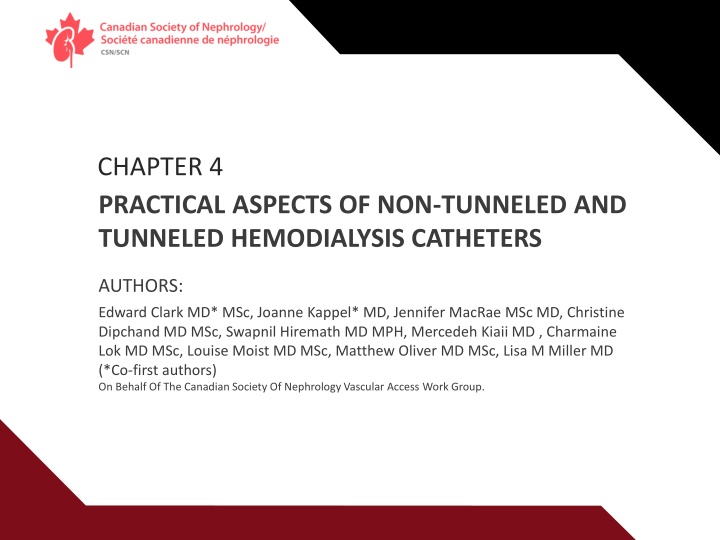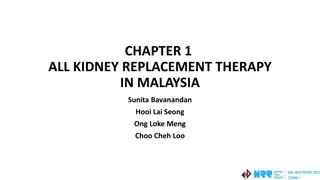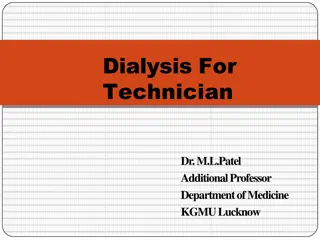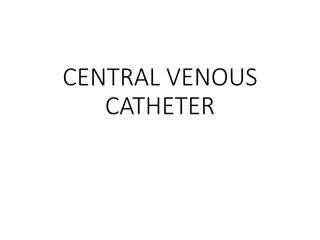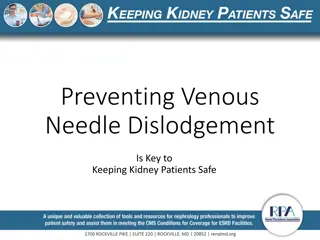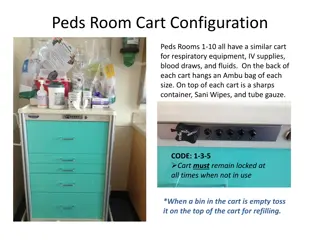Practical Aspects of Hemodialysis Catheters
This chapter discusses the practical aspects of non-tunneled and tunneled hemodialysis catheters, including mechanical and infectious complications, optimal site selection, timing of switching catheters, indications for tunneled catheter use, insertion and care protocols, and more. It emphasizes the preferred sites for insertion, available catheter options, and recommendations for safe and effective vascular access in hemodialysis patients.
Download Presentation

Please find below an Image/Link to download the presentation.
The content on the website is provided AS IS for your information and personal use only. It may not be sold, licensed, or shared on other websites without obtaining consent from the author.If you encounter any issues during the download, it is possible that the publisher has removed the file from their server.
You are allowed to download the files provided on this website for personal or commercial use, subject to the condition that they are used lawfully. All files are the property of their respective owners.
The content on the website is provided AS IS for your information and personal use only. It may not be sold, licensed, or shared on other websites without obtaining consent from the author.
E N D
Presentation Transcript
Vascular Access Education Initiative | 2015 CHAPTER 4 PRACTICAL ASPECTS OF NON-TUNNELED AND TUNNELED HEMODIALYSIS CATHETERS AUTHORS: Edward Clark MD* MSc, Joanne Kappel* MD, Jennifer MacRae MSc MD, Christine Dipchand MD MSc, Swapnil Hiremath MD MPH, Mercedeh Kiaii MD , Charmaine Lok MD MSc, Louise Moist MD MSc, Matthew Oliver MD MSc, Lisa M Miller MD (*Co-first authors) On Behalf Of The Canadian Society Of Nephrology Vascular Access Work Group.
Vascular Access Education Initiative | 2015 CONTENTS Introduction Non-tunneled (temporary) hemodialysis catheters (NTHCs) Mechanical complications of NTHCs Infectious complications of NTHCs Optimal site-selection for NTHC insertion Factors that influence site selection: Internal jugular vs femoral vein Accidental removal of NTHC Timing of switching from a NTHC to tunneled central venous catheter following AKI Tunneled hemodialysis catheters Indication for tunneled catheter use Tunneled cuffed catheter insertion Tunneled cuffed catheter care Tunneled cuffed catheter removal Summary of Recommendations 2
Vascular Access Education Initiative | 2015 INTRODUCTION Non-tunneled (temporary) hemodialysis catheters (NTHCs) are typically used when vascular access is required for urgent renal replacement therapy (RRT) Preferred site for NTHC insertion in acute kidney injury is the right internal jugular vein followed by the femoral vein When aided by real-time ultrasound, mechanical complications related to NTHC insertion are significantly reduced The preferred site for tunneled hemodialysis catheters placement is the right internal jugular followed by the left internal jugular vein Ideally, the catheter should be inserted on the opposite side of a maturing or planned fistula/ graft Several dual lumen, large diameter catheters are available with multiple catheter tip designs, but no one catheter has shown significant superior performance 3
Vascular Access Education Initiative | 2015 MECHANICAL COMPLICATIONS OF NTHCs- ACUTE Occur in up to 5% of insertions - vascular injury or hematoma Other mechanical complications; pneumothorax, pneumopericardium, air and guidewire embolism occur less often but can be fatal Life-threatening complications are typically related to insertions at the internal jugular (IJ) site, however there are reports of fatal complications at the femoral site and severe bleeding (typically retroperitoneal) in approx. 0.5% of cases Cardiac arrhythmia is a potentially serious complication of any CVC insertion; typically relates to over-insertion of the wire (> 20 cm) using the Seldinger technique Patients with AKI have an increased risk of serious ventricular arrhythmia during CVC insertion vs ESR disease or normal kidney function patients 4
Vascular Access Education Initiative | 2015 MECHANICAL COMPLICATIONS OF NTHCs- LONG TERM Central Venous Stenosis (CVS) may occur following catheter insertion Increased risk of CVS if NTHC is inserted into SC veins; avoid whenever possible Possibly due to direct contact between the catheter side-wall and the vascular endothelium Left-sided SC and IJ veins may be associated with increased risk of CVS relative to right-sided ones 5
Vascular Access Education Initiative | 2015 ULTRASOUND USE = REDUCE MECHANICAL COMPLICATIONS Real-time ultrasound guidance dramatically reduces the risk of mechanical complications during NTHCs insertion Table 1: NTHC Location ADVANTAGES OF ULTRASOUND USE Internal Jugular (IJ) - Significantly reduced arterial punctures, hematomas - Insertions were significantly faster; more likely to be successful on 1st attempt - Use is widely considered to be the standard-of-care - Significant reduction in complications; better 1st attempt and overall insertion success - Some authors advocate real-time ultrasound should be the standard-of-care for femoral NTHC insertions Femoral Vein Subclavian (SC) Vein - Avoid whenever possible due to increased risk of central venous stenosis (CVS)! - Should only be performed by operators experienced with the technique 6
Vascular Access Education Initiative | 2015 INFECTIOUS COMPLICATIONS OF NTHCS NTHCs are associated with a higher risk of infection compared to both tunneled HD CVCs and other types of non-tunneled CVCs Rate of CRBSI per 1000 Catheter Days 4.8 2.8 NTHCs Other CVCs NTHCs should be removed immediately if there is evidence of an exit-site infection or a central-line associated bloodstream infection (CLABSI) related to the NTHC Chart Source: Maki, D.G., D.M. Kluger, and C.J. Crnich, The risk of bloodstream infection in adults with different intravascular devices: a systematic review of 200 published prospective studies. Mayo Clin Proc, 2006. 81(9): p. 1159-71. 7
Vascular Access Education Initiative | 2015 OPTIMAL SITE SELECTION FOR NTHCs INSERTION 2012 KDIGO guidelines for AKI recommend the following for NTHC insertion: Right IJ vein Femoral vein Left IJ vein Last choice: SC vein (Dominant side preference) The Cathedia study (2008) of bed-bound, critically ill patients in ICU, found: Overall risk of infection or CLABSI did not differ significantly according to IJ or femoral sites Patients in the highest BMI tercile (>28.4) had a significantly risk of catheter colonization with femoral NTHCs vs IJ Patients in the lowest BMI tercile (<24.2) had a significantly risk of catheter colonization with femoral NTHCs vs IJ 8
Vascular Access Education Initiative | 2015 FACTORS INFLUENCING SITE SELECTION Other considerations that may influence IJ vs Femoral site selection: Internal Jugular (IJ) Site Femoral Site Ambulatory patients or those for whom lower extremity mobility is required for rehab Chronic dialysis patients in whom a functional AVF/AVG, or PD catheter, is present or possible in the near future. Immediate post-operative major abdominal surgery (e.g. abdominal aortic aneurysm repair) Patients requiring emergent HD when the operator is inexperienced or does not have access to ultrasound Active infections affecting groin area, such as acute diarrheal illness or fungal infections Severe coagulopathy Morbid obesity with pannus Prior vascular surgeries (eg/ bypass) affecting the groin and/or lower leg Local expertise and ultrasound available 9
Vascular Access Education Initiative | 2015 ACCIDENTAL REMOVAL OF NTHS Temporary NTHCs are occasionally, unintentionally dislodged Study of patients in ICU shoed rate of accidental removal of IJ catheters and femoral catheters was 0.26 and 0.16 per 100 catheter-days respectfully Death from exsanguination has been reported This highlights importance of adequately securing with sutures or an adhesive device for the duration of use 10
Vascular Access Education Initiative | 2015 SWITCHING FROM NTHC TO TUNNELED CVC The Cathedia study demonstrated that catheter colonization occurs in a linear fashion over time, not exponentially as previously suggested NTHCs should NOT be routinely replaced or used for less than one week, contrary to KDOQI recommendations For chronic HD patients, a tunneled catheter is favoured over NTHCs In the context of AKI, NTHCs should be replaced as soon as it becomes clear that renal recovery is unlikely in the near-term 11
Vascular Access Education Initiative | 2015 TUNNELED HD CATHETERS - INDICATIONS FOR USE CSN Recommendations (2006 and 2012 working group) state preferred access for HD is radio-cephalic native AVF. Despite this, use of tunneled CVCs continues to increase in most Canadian HD units. Multiple reasons for the increased use of catheters: ing age of patients initiating HD ing number of comorbid conditions (e.g. vascular disease) Inadequate preparation prior to the need to initiate HD Inability of patient/family to make a modality choice in a timely manner Scheduled living donor transplant Patient choice Fear of needles Late referral 12
Vascular Access Education Initiative | 2015 INDICATIONS FOR CATHETER USE HD catheter use remains an important choice for vascular access Advantages: Disadvantages Can be used immediately after insertion Can be used for long periods of time (assuming no complications) Provides painless entry into the bloodstream. Immediate complications such as: bleeding, catheter malposition, pneumothorax, air embolism, vascular injury Indications include: Access of choice for temporary HD > 2 - 3 weeks Permanent HD access when no other access is possible, incl. peritoneal dialysis When an AVF or graft is maturing When a peritoneal dialysis catheter is planned/healing When a live donor transplant is scheduled Long term complications such as: Catheter thrombosis Central vein stenosis Fibrin sheath formation Catheter related infections with their sequalae. Contraindications to tunneled catheter insertion include: Coagulation problems (INR >1.5 and/or platelet count <50 x 109/L) and active septicemia Temporary, non-cuffed, non-tunneled HD catheter should be considered in these situations 13
Vascular Access Education Initiative | 2015 TUNNELED CUFFED CATHETER INSERTION http://www.youtube.com/watch?v=HE5QhsPRaPU Choice of Catheter Dual lumen, largest diameter catheter available Derived from silastic elastomers of polyurethane or silicone No one design has shown significant superior performance Use of antimicrobial or heparin impregnated catheters is not recommended due to lack of beneficial data supporting their long- term use 14
Vascular Access Education Initiative | 2015 TUNNELED CUFFED CATHETER INSERTION Catheter Site Selection Right internal jugular (IJ) vein is preferred site for catheter placement, then left IJ vein Should be inserted on opposite side of a maturing/planned AVF/AVG If central veins are occluded, common femoral veins can be used Avoid subclavian veins whenever possible due to incidence of venous stenosis which could compromise future AVF/AVG options Last consideration for insertion is a percutaneous translumbar into the inferior vena cava 15
Vascular Access Education Initiative | 2015 TUNNELED CUFFED CATHETER INSERTION Catheter Placement Technique Mandatory informed consent Sterile technique; consider pre-procedure sedation (fentanyl/midazolam) Ultrasound guided puncture of all venous sites is mandatory Insert catheter percutaneously using a modified Seldinger guide wire technique accompanied by fluoroscopy or ultrasound Fluoroscopy should be used to position the tip of the catheter in the mid right atrium when the patient is supine If fluoroscopy is NOT used, a chest X-ray is recommended post- procedure to ensure proper position Suture both the insertion/exit site (can remove after 3 weeks) and the anterior chest wall puncture site (can remove after 10-14 days) Prophylactic antibiotics are not recommended 16
Vascular Access Education Initiative | 2015 PROLONGED EXIT SITE BLEEDING Prolonged bleeding following tunneled catheter insertion <0.1% of patients experience prolonged oozing or overt bleeding that requires a transfusion or other intervention When prolonged oozing or bleeding occurs in the absence of hypotension or other contraindications, the patient should be maintained in an upright position to reduce central venous pressure If uremic bleeding is suspected, administration of desmopressin (DDAVP) or other agents may be considered If application of pressure dressings and/or local pressure remains ineffective at stemming oozing or bleeding, placement of a purse- string suture at the tunnel exit site can often facilitate hemostasis 17
Vascular Access Education Initiative | 2015 TUNNELED CUFFED CATHETER CARE Suitable Locking Solutions Sodium citrate (4%) or concentrated heparin solutions (1000 units/ml); higher concentration heparin 5000-10,000 u/ml is reserved for patients who develop catheter thrombosis No difference between solutions in terms of thrombolytic use or catheter removal for poor flow Bleeding rates may be lower with sodium citrate More frequent biofilm characteristics have been associated with heparin than with citrate use With higher citrate concentrations, there is a risk of hypocalcemia and cardiac arrhythmias Antibiotic locks (gentamicin/citrate) have been associated with fewer catheter related infections; use should be dictated by local infection rates 18
Vascular Access Education Initiative | 2015 TUNNELED CUFFED CATHETER CARE Exit Site Care Practice proper hand hygiene; wear clean gloves Masks/face shields for both patient and healthcare provider should be worn Some centers apply povidone-iodine or polysporin ointment to the exit site Avoid mupirocin ointment; risk of developing antimicrobial resistance Some ointments may not be compatible with certain HD catheters; review manufacturers recommendations before applying Use sterile gauze or transparent semi-permeable dressings to cover the catheter exit site CSN guidelines (2006) recommend exit site dressing changes at every HD treatment 19
Vascular Access Education Initiative | 2015 TUNNELED CUFFED CATHETER REMOVAL https://www.youtube.com/watch?v=0IfjE0G9C_M or https://www.youtube.com/watch?v=DGya15H_Jfw Simple traction can be used to remove catheters (< 3 weeks old) Local anesthetic, sterile technique and minor surgical cut down to remove the cuff (catheter > 3 weeks old) In the case of sepsis, the catheter tip should be sent for culture Catheter removal may be difficult if the catheter is tethered or embedded; assistance from interventional radiology or surgery should be considered Accidental tunneled catheter removal can occur; due to line not securely in place within subcutaneous tissue, or tunnel infection New site for insertion is mandatory 20
Vascular Access Education Initiative | 2015 SUMMARY OF RECOMMENDATIONS NTHCs are typically used for vascular access for urgent hemodialysis In general, the preferred site for NTHC insertion in AKI is the right IJ vein followed by the femoral vein; however, additional factors should be taken into account to ensure optimal site selection When aided by real-time ultrasound, mechanical complications related to NTHC insertion are significantly reduced NTHCs should be removed immediately if there is evidence of an exit-site infection or a CRBSI related to the NTHC For chronic HD patients, permanent access is recommended over NTHC Replacement of NTHC is recommended as soon as it becomes clear that renal recovery is unlikely in the near-term 21
Vascular Access Education Initiative | 2015 SUMMARY OF RECOMMENDATIONS Tunneled central venous catheters are commonly used for hemodialysis access, with incident use in Canadian facilities ~ 80% While arteriovenous access is recommended, clinical situations where catheters may be considered include: temporary hemodialysis greater than 2 3 weeks while an arteriovenous access is maturing while a peritoneal dialysis catheter is planned or healing when a live donor transplant is scheduled when no other access (including peritoneal dialysis) is possible Several dual lumen, large diameter catheters are available, and may be derived from silastic elastomers of polyurethane or silicone. Multiple catheter tip designs exist, but no one design has shown significant superior performance 22
Vascular Access Education Initiative | 2015 SUMMARY OF RECOMMENDATIONS Sterile technique during catheter insertion and removal is mandatory Catheters are inserted percutaneously using a modified Seldinger guide wire technique using either fluoroscopy or ultrasound Preferred site for catheter placement is the right internal jugular vein followed by the left internal jugular vein. Ideally, the catheter should be inserted on the opposite side of a maturing or planned arteriovenous access Subclavian veins should be avoided whenever possible due to the increased incidence of venous stenosis Exit-site care is extremely important in reducing the risk of catheter-related infections 23
